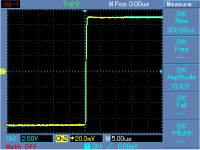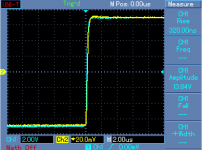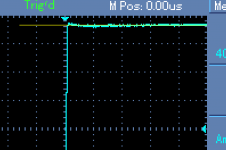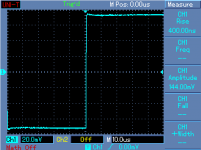I am not sure if I understand the word 'hook' regarding the plot.
PMA - I've completely lost the drift here, are you saying this has nothing to do with DA, series inductance, or what?
Let me try to explain what is being discussed here. About 35 years ago, a Tektronix engineer or two wrote an article on 'CIRCUIT HOOK' (as far as I can distinctly remember) which is a rather strange characterization of a circuit 'glitch'. They were designing attenuators, and they found a problem. Guess what? It was the SAME problem that PMA has just found and fixed! It was due to DA in the system, in the circuit board in Tek's case, and in the poly cap, in YBA's case.
Now why did they call it HOOK?
If YBA can remeasure the problem and EXAGGERATE the problem, so that the DIFFERENCE between ideal and the problem is easy to see, then you can sort of see a HOOK in the ERROR difference. I hope that this helps. I am not trying to talk in code, or anything, but to point out that YBA is not alone with his discovery, and it should be noted by virtually anyone making attenuators, if they really care about optimum performance.
Now why did they call it HOOK?
If YBA can remeasure the problem and EXAGGERATE the problem, so that the DIFFERENCE between ideal and the problem is easy to see, then you can sort of see a HOOK in the ERROR difference. I hope that this helps. I am not trying to talk in code, or anything, but to point out that YBA is not alone with his discovery, and it should be noted by virtually anyone making attenuators, if they really care about optimum performance.
Perhaps I went in the wrong direction. PMA, please slow the rep speed and 'contain' the overshoot so that it sort of looks like a 'hook'.
The measurements I am showing are 1 year old. I can add a couple of measurements in a different time axis resolution, but with same circuit, signal and phenomenon. I hope it helps, at least a little.
Attachments
The plots are 1 year old and I have no other plots with me.
We have the data with enough resolution (12-bit A/D) captured at the site, but I have no access to them at the moment.
But IMO you can easily see it even in these low resolution plots.
We have the data with enough resolution (12-bit A/D) captured at the site, but I have no access to them at the moment.
But IMO you can easily see it even in these low resolution plots.
Attachments
Last edited:
> .... an article from either the IRT (IRT :: Home) or the VDT (http://www.tonmeister.de) Journal quite a few years back ....
> ... the VDT and IRT sites are goldmines of information, ....
Thorsten,
Where can I find their publications or articles ?
Could you kindly post a link ?
Thanks,
Patrick
> ... the VDT and IRT sites are goldmines of information, ....
Thorsten,
Where can I find their publications or articles ?
Could you kindly post a link ?
Thanks,
Patrick
Hi,
I have not found an obvious index, such as for the old technical bulletins of the Beep on their site (Beep = UK Slang for BBC). So for my article I have to get to the paper, for anything else, just snoop around. There is plenty of acoustical stuff...
Ciao T
Where can I find their publications or articles ?
Could you kindly post a link ?
I have not found an obvious index, such as for the old technical bulletins of the Beep on their site (Beep = UK Slang for BBC). So for my article I have to get to the paper, for anything else, just snoop around. There is plenty of acoustical stuff...
Ciao T
Folks,
I found on line the circuit diagrams for some of the old east german "HiFi" gear I grew up with, modified and generally messed with and so on and on... It sounded pretty decent to me at the time.
I had FM Radio from "Sender Freies Berlin" and "Radio Im Amerikanischen Sektor" (both West Berlin stations that transmitted deep into east germany AND had very good transmitting quality) and LP's bought for more or less legally acquired Dollars in the East German Dollar Shops (Intershop). I used to make pencil drawings of landmarks on A3 for fun, until I found out that West German and American Tourists would pay surprising amounts of real hard cash (not the local mikey mouse money) for these.
Actually, to me 50 Deutschmark - that is around 20 USD at the time - which I often got for my A3 sized ones was a lot of money almost a month salary for a worker. To the Tourists it was likely just a trifle. I never thought I was real good at that drawing business, so I never tried to study art, but who knows...
I did take the money though and converted some into ost mark (illegally) to buy HiFi and other stuff and used the rest to buy LP's of music one could just not get in East Germany (except in the Dollar Shops).
Add to that East German and Eastern Block LP's of "Ernste Musik" (classical etc.) and East German radio stations with extremely high transmission quality but only worth listening to for Classical and maybe Jazz, nothing contemporary and I actually enjoyed embarrassing riches in musical culture in my teens, I even had a subscription at the local Theater for all the classical concerts, on average every two weeks and went to the local youth club for Beat & Rock music concerts and Disco...
What a trip down memory lane!
What struck me perhaps most looking that these old, nostalgic pages of schematics was, that while perhaps there are many areas where we would turn up our collective noses these days, at the core there are a few interesting things about this gear that have bearing here and are very pertinent to the debate...
Of course, the stuff was discrete circuitry. One Radio I had and liked a lot had three silicone transistors in the Preamp (no phono, they where build into the turntable).
It started with one emitter follower buffering the lowish impedance volume control (with a true and quite functional "loudness" control using a three-tapped linear carbon track pot), then an open loop gain stage with bootstrapped input to minimally load the volume control and a gain of around 10.
This was followed by a low impedance passive Baxandall tonestack and another gainstage with a gain of around 10. All small capacitors polystyrene & metal foil, including loudness and tone control.
Of course, coupling used all electrolytic capacitors, of the "glatte folie" type, that means smooth foil, without etching to increase the available surface and capacitance, which are much less worse sonically when correctly biased than modern types IMNSHO, but they are 'lytics...
The poweramp used classic single ended input circuitry (no differential here) using two NPN Transistors and a Level Shifter Zenner to the second stage which had a low impedance bootstrapped load. This drove quasi complementary 2N3055 outputs with big heatsinks and a lot of quiescent current, single rail with output coupling cap. Open loop gain estimated maybe 50dB or so, could be less, estimated open loop bandwidth > 50Khz, 26dB closed loop gain, 25W into 4 Ohm output, no protection circuitry whatsoever.
The speakers (that came with the Radio) had a 20cm paper cone/rubber surround woofer in a 20 Liter sealed box and a 15cm * 9cm (appx) oval paper cone "tweeter" with maybe 800Hz first order crossover (so today we would probably call this a "FAST" type speaker.
So in some ways perhaps it was no surprise that all this stuff sounded good to my ears and that it seemed to excel in bring the music to life, communicating the emotions.
So, today I listen to a system that is very different, with silver wires and silver capacitors everywhere, but it uses no overall loop feedback, simple, straightforward circuitry and is only missing tone controls and a correct loudness to make even late night listening at low levels enjoyable.
So to me, nothing much has changed. Who knows, had I not grown up with Tube Radios and such old style HiFi, but instead with japanese gear that boasted 0.000000001% THD at full power and without the frequent concerts I would like this "High Feedback, No Emotion" sound and delude myself into believing that it actually is good and resembles real music...
Well, just some ramblings about this, that and ancient history. I sign off here...
Ciao T
I found on line the circuit diagrams for some of the old east german "HiFi" gear I grew up with, modified and generally messed with and so on and on... It sounded pretty decent to me at the time.
I had FM Radio from "Sender Freies Berlin" and "Radio Im Amerikanischen Sektor" (both West Berlin stations that transmitted deep into east germany AND had very good transmitting quality) and LP's bought for more or less legally acquired Dollars in the East German Dollar Shops (Intershop). I used to make pencil drawings of landmarks on A3 for fun, until I found out that West German and American Tourists would pay surprising amounts of real hard cash (not the local mikey mouse money) for these.
Actually, to me 50 Deutschmark - that is around 20 USD at the time - which I often got for my A3 sized ones was a lot of money almost a month salary for a worker. To the Tourists it was likely just a trifle. I never thought I was real good at that drawing business, so I never tried to study art, but who knows...
I did take the money though and converted some into ost mark (illegally) to buy HiFi and other stuff and used the rest to buy LP's of music one could just not get in East Germany (except in the Dollar Shops).
Add to that East German and Eastern Block LP's of "Ernste Musik" (classical etc.) and East German radio stations with extremely high transmission quality but only worth listening to for Classical and maybe Jazz, nothing contemporary and I actually enjoyed embarrassing riches in musical culture in my teens, I even had a subscription at the local Theater for all the classical concerts, on average every two weeks and went to the local youth club for Beat & Rock music concerts and Disco...
What a trip down memory lane!
What struck me perhaps most looking that these old, nostalgic pages of schematics was, that while perhaps there are many areas where we would turn up our collective noses these days, at the core there are a few interesting things about this gear that have bearing here and are very pertinent to the debate...
Of course, the stuff was discrete circuitry. One Radio I had and liked a lot had three silicone transistors in the Preamp (no phono, they where build into the turntable).
It started with one emitter follower buffering the lowish impedance volume control (with a true and quite functional "loudness" control using a three-tapped linear carbon track pot), then an open loop gain stage with bootstrapped input to minimally load the volume control and a gain of around 10.
This was followed by a low impedance passive Baxandall tonestack and another gainstage with a gain of around 10. All small capacitors polystyrene & metal foil, including loudness and tone control.
Of course, coupling used all electrolytic capacitors, of the "glatte folie" type, that means smooth foil, without etching to increase the available surface and capacitance, which are much less worse sonically when correctly biased than modern types IMNSHO, but they are 'lytics...
The poweramp used classic single ended input circuitry (no differential here) using two NPN Transistors and a Level Shifter Zenner to the second stage which had a low impedance bootstrapped load. This drove quasi complementary 2N3055 outputs with big heatsinks and a lot of quiescent current, single rail with output coupling cap. Open loop gain estimated maybe 50dB or so, could be less, estimated open loop bandwidth > 50Khz, 26dB closed loop gain, 25W into 4 Ohm output, no protection circuitry whatsoever.
The speakers (that came with the Radio) had a 20cm paper cone/rubber surround woofer in a 20 Liter sealed box and a 15cm * 9cm (appx) oval paper cone "tweeter" with maybe 800Hz first order crossover (so today we would probably call this a "FAST" type speaker.
So in some ways perhaps it was no surprise that all this stuff sounded good to my ears and that it seemed to excel in bring the music to life, communicating the emotions.
So, today I listen to a system that is very different, with silver wires and silver capacitors everywhere, but it uses no overall loop feedback, simple, straightforward circuitry and is only missing tone controls and a correct loudness to make even late night listening at low levels enjoyable.
So to me, nothing much has changed. Who knows, had I not grown up with Tube Radios and such old style HiFi, but instead with japanese gear that boasted 0.000000001% THD at full power and without the frequent concerts I would like this "High Feedback, No Emotion" sound and delude myself into believing that it actually is good and resembles real music...
Well, just some ramblings about this, that and ancient history. I sign off here...
Ciao T
Thanks for posting those posts Thorsten.
Probably has a lot to do with it. But, people change beliefs about sound as well. It's all about relearning and not always an easy thing to do. That's what I'm doing, in desensitizing my ears to sounds I have "dislike" for - retraining the auditory subconscious through exposure desensitizaton. Abstract stuff.
I read in Stereophile in the early 90's that Steven Stone was really hot for single ended tube gear when he first joined that magazine as a reviewer. But, he also attended concerts with JGH and they made recordings of the Boulder Symphony. With some convincing, he changed his opinion and became more of a solid state guy, and a fan the Boulder amps which Holt really liked.
We also own the same Boulder amps JGH liked and they are not "no emotion" sound, and have lots of feedback. They sound very natural, neutral, to our ears, in our system. My dad does attend concerts and I used to.
Are many paths to a great amp designs, I think.
ThorstenL said:So to me, nothing much has changed. Who knows, had I not grown up with Tube Radios and such old style HiFi, but instead with japanese gear that boasted 0.000000001% THD at full power and without the frequent concerts I would like this "High Feedback, No Emotion" sound and delude myself into believing that it actually is good and resembles real music...
Probably has a lot to do with it. But, people change beliefs about sound as well. It's all about relearning and not always an easy thing to do. That's what I'm doing, in desensitizing my ears to sounds I have "dislike" for - retraining the auditory subconscious through exposure desensitizaton. Abstract stuff.
I read in Stereophile in the early 90's that Steven Stone was really hot for single ended tube gear when he first joined that magazine as a reviewer. But, he also attended concerts with JGH and they made recordings of the Boulder Symphony. With some convincing, he changed his opinion and became more of a solid state guy, and a fan the Boulder amps which Holt really liked.
We also own the same Boulder amps JGH liked and they are not "no emotion" sound, and have lots of feedback. They sound very natural, neutral, to our ears, in our system. My dad does attend concerts and I used to.
Are many paths to a great amp designs, I think.
Last edited:
Steve Stone had both a JC-80 and a Vendetta phono stage. I think that he still has the Vendetta, and this was before 'Stereophile'.
I would think anyone would be happy with the JC-80, the one we listened to with John Dennison sounded quite fine and I would not want anything more from a phono stage.
Steve Stone had both a JC-80 and a Vendetta phono stage. I think that he still has the Vendetta, and this was before 'Stereophile'.
I don't know much about Steve's history, but there was what I'd call a fad for single ended tube gear in the early 90's. I'd go into audio shops and they tell us how great all the Cary gear was and that it was the best. Kind of what J Gordon Holt said in the post by ThorstenL about experts.
These amps would sound lifeless and distorted to us. But they loved them.
I built a "single-ended triode" amplifier in 1994 in an attempt to see for myself what the hubbub was all about. The commercially available models like Cary, etc. were just guitar effects pedals and I wanted to see if the touted virtues were real - monotonicity, intrinsic linearity, no loop feedback, etc. but with the best attempt at linearity I could make and an output of +13dBW/channel.
It was educational, but would have been moreso if I hadn't built both channels and the power supplies onto a single chassis. I've had several ideas to update it, but can no longer pick it up off the floor. Not my brightest idea, fersure.
Thanks,
Chris
It was educational, but would have been moreso if I hadn't built both channels and the power supplies onto a single chassis. I've had several ideas to update it, but can no longer pick it up off the floor. Not my brightest idea, fersure.
Thanks,
Chris
John http://www.semicon.toshiba.co.jp/docs/datasheet/en/Transistor/2SC3324_en_datasheet_071101.pdf
Last week I got in a http://www.southernrfmv.com/files/3CX15000A7.pdf I would try it as a directly heated cathode SE amp except the socket is $450! The filament is 6.3 volts but 160 amps!
Last week I got in a http://www.southernrfmv.com/files/3CX15000A7.pdf I would try it as a directly heated cathode SE amp except the socket is $450! The filament is 6.3 volts but 160 amps!
Hi,
Funny story.
In the 90's a friend had a Studio, with the big PMC Monitors and PMC Subs. Amplified actively by PMC approved Amplifiers and Crossovers (I shall not name the company). It sounded lifeless, harsh and with no "air" or "soundscape". He heard my Watt/Puppy inspired Speakers driven by a 300B PSE Amp...
We ended up re-activating his Setup with a Focal tweeter replacing the Vifa, (the 3" Vifa Mid stayed), Shop-soiled Cary SE Amp's for mid (845) and treble (300B) and old Krells for Bass and a heavily modified BSS digital crossover which was also used to time align the shooting match.
Afterwards the system sounded much more realistic and alive, though there where many factors we changed, not just SS to SE.
But we also changed from a speaker with a messy impulse response and poor treble dispersion control and waterfall (and sound) to better controlled directivity, cleaner waterfall (well up to around 23KHz), flatter frequency response, near ideal pulse coherence of the speaker at the listening position and so on.
I also suspect the DA converters in the BSS where better than what was in his old ADAT system, so feeding the digital crossover directly with digital data and adjusting levels after the DAC likely helped...
Ciao T
I'd go into audio shops and they tell us how great all the Cary gear was and that it was the best. Kind of what J Gordon Holt said in the post by ThorstenL about experts.
These amps would sound lifeless and distorted to us. But they loved them.
Funny story.
In the 90's a friend had a Studio, with the big PMC Monitors and PMC Subs. Amplified actively by PMC approved Amplifiers and Crossovers (I shall not name the company). It sounded lifeless, harsh and with no "air" or "soundscape". He heard my Watt/Puppy inspired Speakers driven by a 300B PSE Amp...
We ended up re-activating his Setup with a Focal tweeter replacing the Vifa, (the 3" Vifa Mid stayed), Shop-soiled Cary SE Amp's for mid (845) and treble (300B) and old Krells for Bass and a heavily modified BSS digital crossover which was also used to time align the shooting match.
Afterwards the system sounded much more realistic and alive, though there where many factors we changed, not just SS to SE.
But we also changed from a speaker with a messy impulse response and poor treble dispersion control and waterfall (and sound) to better controlled directivity, cleaner waterfall (well up to around 23KHz), flatter frequency response, near ideal pulse coherence of the speaker at the listening position and so on.
I also suspect the DA converters in the BSS where better than what was in his old ADAT system, so feeding the digital crossover directly with digital data and adjusting levels after the DAC likely helped...
Ciao T
- Status
- Not open for further replies.
- Home
- Member Areas
- The Lounge
- John Curl's Blowtorch preamplifier part II



